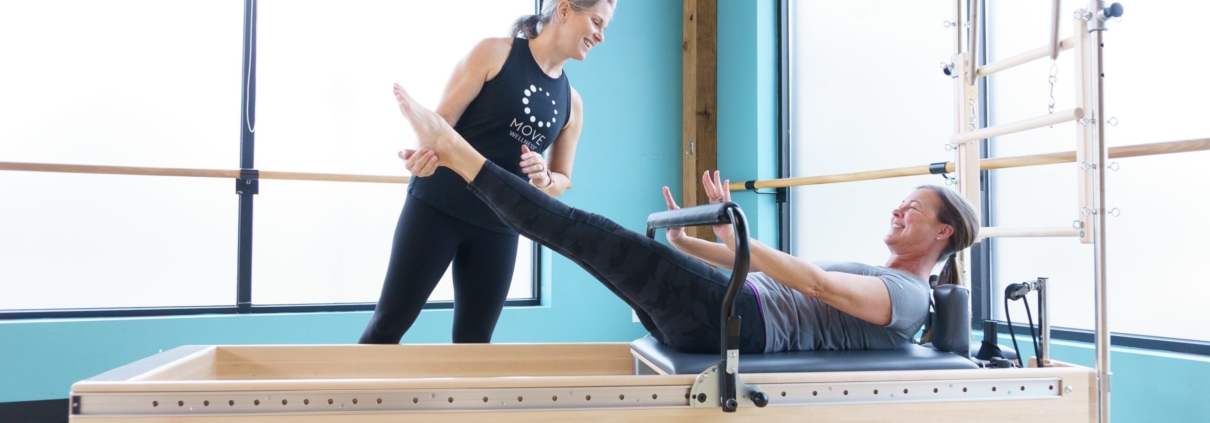How Pilates and physical therapy can work together
Pilates is sometimes recommended as a rehabilitative exercise after physical therapy to help avoid re-injury. Physical therapy and Pilates can work together to help build a stronger, more balanced body.
What is Pilates?
Pilates is an exercise system developed by boxer and gymnast Joseph Pilates in the early 20th century. It uses resistance and your own body weight to stabilize your core and strengthen your body. Pilates exercises can be done on a mat or on specialized equipment.
Pilates focuses on key alignment principles and how the muscular, skeletal and nervous systems work together to reeducate movement patterns.
What is physical therapy?
Physical therapy is a form of health care that “aims to ease pain and help you function, move, and live better.” It can be used to relieve pain, improve mobility and balance, or as rehabilitation after illness or injury. While physical therapy often focuses on specific injury recovery, Pilates emphasizes functional movement patterns to enhance overall physical function.
(source)
Is Pilates the same as physical therapy?
No. Although Pilates and physical therapy can both help strengthen the body and improve your range of movement, the methodologies behind them and the techniques used are different.
How do Pilates and physical therapy work together?
Pilates is sometimes recommended as a rehabilitative exercise post-therapy to help further support functional movement and prevent re-injury. There are a number of ways that Pilates and physical therapy complement each other:
1. Improves coordination, flexibility, and balance
Pilates exercises help lengthen the muscle and improve flexibility, which allows you to achieve a greater range of motion. This helps reduce the risk of re-injury after physical therapy.
As ability, strength, and coordination increase, your instructor can add complexity and more challenging Pilates exercises to help you keep progressing safely.
2. Strengthens the pelvic floor
People who have received treatment for issues like urinary incontinence, frequent urination, or pelvic pain through pelvic health physical therapy will find that Pilates is useful in continuing to work and strengthen the deep abs and pelvic floor.
Pilates for the pelvic floor can release stress, relieve lower back pain, and help improve pelvic floor disorders, including urinary incontinence. Some Pilates studios even offer special prenatal Pilates classes that help strengthen the pelvic floor in preparation for childbirth and to help prevent common delivery issues.
3. Safely builds muscle strength
Pilates is an effective strength training workout for all ages and fitness levels. These types of weight-bearing exercises can be used to safely continue building strength post-therapy.
MOVE Wellness offers both Pilates and physical therapy services out of our studio in Ann Arbor, Michigan.
Finding a Pilates Physical Therapist
Finding a good physical therapist is the first step in your recovery journey. A licensed physical therapist can help you achieve your goals and a safe and effective treatment plan. When looking for a physical therapist, be sure to:
- Check Credentials: Look for a physical therapist who is licensed and certified by the American Board of Physical Therapy Specialties (ABPTS). This means they have the education, training and experience to provide high quality care.
- Ask for Referrals: Ask your doctor, friends or family members for recommendations. They may have had a good experience with a physical therapist before.
- Check Online Reviews: Look up physical therapists in your area and read online reviews. Look at the overall rating and comments from previous patients.
- Check Their Experience: Look for a physical therapist who has experience with patients who have the same condition as you. This means they have the knowledge and skills to provide effective treatment.
- Check Their Approach: Look for a physical therapist who uses a holistic approach to treatment. This means they will consider your overall health and well being, not just your injury or condition.
Creating a Personalized Treatment Plan
A personalized treatment plan is a customized approach to your recovery that takes into account your unique needs and goals.
- Initial Consultation: The first step in creating a personalized treatment plan is to schedule an initial consultation with a physical therapist. During this consultation the physical therapist will assess your condition, discuss your goals and create a treatment plan tailored to your needs.
- Assessment: The physical therapist will assess your condition by performing a physical examination, reviewing your medical history and discussing your symptoms. This will help them understand your condition and create a treatment plan tailored to your needs.
- Goal Setting: The physical therapist will work with you to set realistic goals for your recovery. This may be to improve your range of motion, reduce pain or increase your strength and flexibility.
- Treatment Plan: The physical therapist will create a treatment plan tailored to your needs and goals. This may include a combination of manual therapy, exercise and education.
- Progress Monitoring: The physical therapist will monitor your progress and adjust your treatment plan as needed. This will ensure you are making progress towards your goals and your treatment plan is working.
Pilates
Our Pilates trainers specialize in working with special populations, including those who are injured. We can even coordinate with other therapists and physicians on your treatment team to provide optimal support.
Let us know what issues you are working with and we will help you schedule with a trainer that can support you on your fitness journey. With our private Pilates training, you’ll get one-on-one attention and a workout plan customized to your goals.
Physical therapy
MOVE partners with two on-site physical therapists; Sara Thorne of Sara Thorne Physical Therapy and Melissa Trauger of Rhapsody of Motion. We are proud to be able to provide our clients with options for on-site physical therapy services with physical therapists who specialize, but are not limited to, working with clients to address pelvic health issues and orthopedic challenges.
Collaborating with area physicians and physical therapists like Melissa and Sara is important to providing our clients an excellent continuum of care. Working in partnership with physical therapists allows us to help to provide manual therapy, assess injuries, and collaborate on movement goals.
Interested in learning more about these or other services? Contact us today!




Leave a Reply
Want to join the discussion?Feel free to contribute!